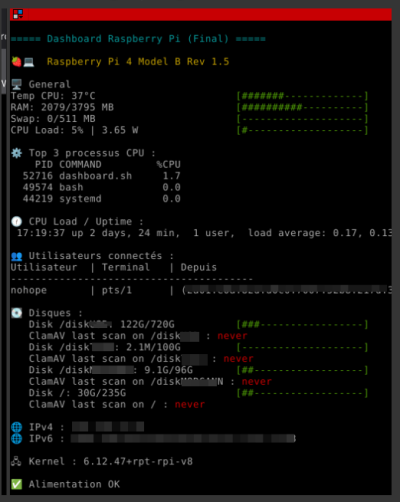Dashboard Raspberry
Juste un petit tableau de bord de l'état de santé de votre raspberry (perso. un raspberry 4B), mais fonctionnel sur un pi zero et un 5.
- download
#!/bin/bash # ========================================== # Dashboard Raspberry Pi complet # Barres alignées, disques "utilisé/total", utilisateurs # ========================================== # --- Couleurs --- RED="\e[31m" ORANGE="\e[33m" GREEN="\e[32m" CYAN="\e[36m" RESET="\e[0m" BAR_LEN=20 # longueur barre VALUE_COL=35 # colonne fixe pour aligner toutes les barres # --- Fonction barre ASCII --- bar() { local pct=$1 local length=$2 local filled=$((pct * length / 100)) local empty=$((length - filled)) local color=$GREEN if [ "$pct" -ge 90 ]; then color=$RED elif [ "$pct" -ge 70 ]; then color=$ORANGE fi printf "${color}[" for ((i=0;i<filled;i++)); do printf "#"; done for ((i=0;i<empty;i++)); do printf "-"; done printf "]${RESET}\n" } # --- Affiche ligne avec barre alignée --- print_line() { local label="$1" local value="$2" local pct=$3 local padding=$((VALUE_COL - ${#label} - ${#value})) [ $padding -lt 1 ] && padding=1 printf "%s: %s%*s" "$label" "$value" $padding "" bar "$pct" $BAR_LEN } # --- CPU load et uptime --- get_cpu_uptime() { echo "🕧 CPU Load / Uptime :" uptime echo "" } # --- Température CPU --- get_temp() { if [ -f /sys/class/thermal/thermal_zone0/temp ]; then RAW=$(cat /sys/class/thermal/thermal_zone0/temp) TEMP=$(awk "BEGIN {printf \"%.0f\", $RAW/1000}") print_line "Temp CPU" "${TEMP}°C" "$TEMP" fi } # --- RAM / Swap --- get_memory() { MEM_TOTAL=$(free -m | awk '/^Mem:/ {print $2}') MEM_USED=$(free -m | awk '/^Mem:/ {print $3}') MEM_PCT=$((MEM_USED * 100 / MEM_TOTAL)) SWAP_TOTAL=$(free -m | awk '/^Swap:/ {print $2}') SWAP_USED=$(free -m | awk '/^Swap:/ {print $3}') SWAP_PCT=$((SWAP_TOTAL==0 ? 0 : SWAP_USED * 100 / SWAP_TOTAL)) print_line "RAM" "${MEM_USED}/${MEM_TOTAL} MB" "$MEM_PCT" print_line "Swap" "${SWAP_USED}/${SWAP_TOTAL} MB" "$SWAP_PCT" } # --- CPU Load + consommation --- get_cpu_load() { read cpu user nice system idle iowait irq softirq steal guest < /proc/stat total1=$((user+nice+system+idle+iowait+irq+softirq+steal)) idle1=$((idle+iowait)) sleep 0.5 read cpu user nice system idle iowait irq softirq steal guest < /proc/stat total2=$((user+nice+system+idle+iowait+irq+softirq+steal)) idle2=$((idle+iowait)) total_diff=$((total2 - total1)) idle_diff=$((idle2 - idle1)) CPU_LOAD=$((total_diff==0 ? 0 : (100*(total_diff-idle_diff)/total_diff))) power=$(awk -v cpu_load_val=$CPU_LOAD 'BEGIN {printf "%.2f", 3.5 + (cpu_load_val/100)*3}') print_line "CPU Load" "${CPU_LOAD}% | ${power} W" "$CPU_LOAD" } # --- Top 3 processus CPU --- top_processes() { echo "" echo -e "⚙️ Top 3 processus CPU :" ps -eo pid,comm,%cpu --sort=-%cpu | head -n 4 echo "" } # --- Disques --- print_disk_info() { MOUNT=$1 INFO=$(df -h "$MOUNT" 2>/dev/null | tail -1 | awk '{print $1, $2, $3, $4, $5}') if [ -n "$INFO" ]; then USED=$(echo "$INFO" | awk '{print $3}') TOTAL=$(echo "$INFO" | awk '{print $2}') USAGE=$(echo "$INFO" | awk '{print $5}' | tr -d '%') VALUE="${USED}/${TOTAL}" print_line " Disk $MOUNT" "$VALUE" "$USAGE" fi } # --- IPs --- print_ip() { IP4=$(ip -4 addr show scope global | grep inet | awk '{print $2}' | cut -d/ -f1 | head -n1) IP6=$(ip -6 addr show scope global | grep inet6 | awk '{print $2}' | cut -d/ -f1 | head -n1) echo -e "🌐 IPv4 : $IP4\n🌐 IPv6 : $IP6\n" } # --- Kernel --- get_kernel() { echo -e "🖧 Kernel : $(uname -r)\n" } # --- Vérification undervoltage --- check_undervoltage() { if ! command -v vcgencmd &>/dev/null; then echo "ℹ️ vcgencmd non disponible" return fi if [ ! -r /dev/vcio ]; then echo "⚠️ Accès à /dev/vcio refusé" return fi THROTTLE=$(vcgencmd get_throttled 2>/dev/null) if [[ $THROTTLE != "throttled=0x0" ]]; then echo -e "⚠️ Undervoltage / Throttling détecté ($THROTTLE)\n" else echo -e "✅ Alimentation OK\n" fi } # --- Utilisateurs connectés --- print_users() { echo -e "👥 Utilisateurs connectés :" printf "%-12s | %-10s | %-8s\n" "Utilisateur" "Terminal" "Depuis" echo "----------------------------------------" who | awk '{printf "%-12s | %-10s | %-8s\n", $1, $2, $5}' echo "" } # --- Dernier passage ClamAV avec couleur --- print_clamav_last_run() { local mount=$1 local ts_file="/var/log/clamscan-last-$(basename "$mount").timestamp" local color=$GREEN local last_run="never" if [ -f "$ts_file" ]; then last_run=$(cat "$ts_file") # Calculer l'âge du scan en heures local last_epoch=$(date -d "$last_run" +%s) local now_epoch=$(date +%s) local age_hours=$(( (now_epoch - last_epoch) / 3600 )) if [ "$age_hours" -le 24 ]; then color=$GREEN elif [ "$age_hours" -le 72 ]; then color=$ORANGE else color=$RED fi else color=$RED fi printf " ClamAV last scan on %s : ${color}%s${RESET}\n" "$mount" "$last_run" } # --- Rapsberry modèle --- RASPBERRY_MODEL=$(cat /sys/firmware/devicetree/base/model | tr -d '\0') # --- Exécution principale --- echo -e "${CYAN}===== Dashboard Raspberry Pi (Final) =====${RESET}\n" echo -e "🍓💻 ${ORANGE} ${RASPBERRY_MODEL} ${RESET}\n" echo "🖥️ General" get_temp get_memory get_cpu_load top_processes get_cpu_uptime print_users echo "💽 Disques :" MOUNTS=("/diskTOTO" "/diskTITA" "/diskTATA" "/") for MOUNT in "${MOUNTS[@]}"; do print_disk_info "$MOUNT" print_clamav_last_run "$MOUNT" done echo "" print_ip get_kernel check_undervoltage echo -e "${CYAN}==============================================${RESET}"
Vous avez juste à adapter la section
- download
echo "💽 Disques :" MOUNTS=("/diskTOTO" "/diskTITA" "/diskTATA" "/") for MOUNT in "${MOUNTS[@]}"; do print_disk_info "$MOUNT" print_clamav_last_run "$MOUNT" done echo ""
En mettant les disques que vous souhaitez analyser
Commenter la ligne
- download
print_clamav_last_run "$MOUNT"
Si vous n'avez pas installer ça https://cbiot.fr/dokuwiki/clamav
